
Labour history
This guide outlines resources about labour history in New Zealand and the wider Pacific, including the organised workers’ movement, trade unions, economic activity and everyday working life.
About this guide
The Alexander Turnbull Library holds a significant amount of material about economic activity, industrial relations and working life in New Zealand (and abroad). This includes the records of workers’ organisations such as unions and political groups, as well as employer federations, companies, families and people. These come in a range of formats such as manuscripts, oral histories, ephemera, cartoons, photographs and more.
This guide is snapshot of some of the unpublished material we hold. Because it only highlights a small amount of the collections, it also contains search tips on how to find more. For information about a person’s life, our family history guides are useful. We also have political history and queer history guides.
Family History
Political History
Queer History
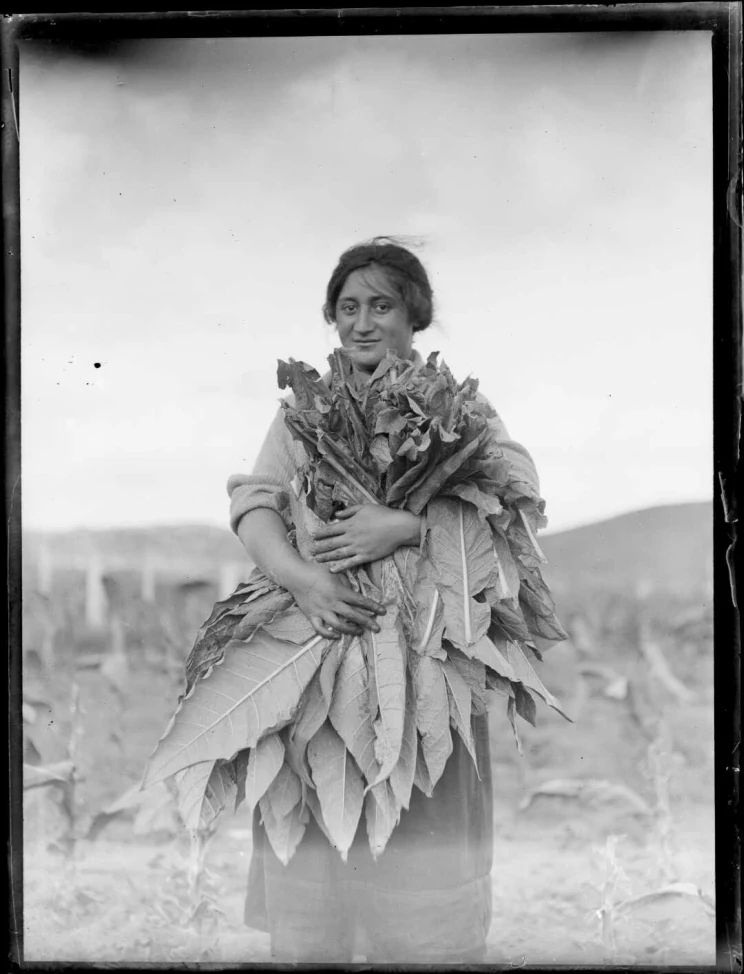
Unidentified Māori worker with tobacco leaves, c.1929. Ref: WA-25301-G. Alexander Turnbull Library.
What is labour history?
As a field of social history, labour history is sometimes called radical history, history from below, people’s history or working-class history. Labour history used to mean the study of trade unions and the organised labour movement. It tended to focus on institutions and the (mostly male) leaders of those institutions. This has shaped what archives have been kept.
Today, labour history is far more expansive, covering all of those who have made the modern world through their work. This includes research about class composition, relations of race and gender, sexuality, disability, unpaid and unfree labour, different types of work and workplaces, culture and the experience of everyday life, health and safety, capitalism, state power, protest and forms of collective action, migration and transnationalism, and more-than-human histories (such as the work of animals and the extra-human environment).
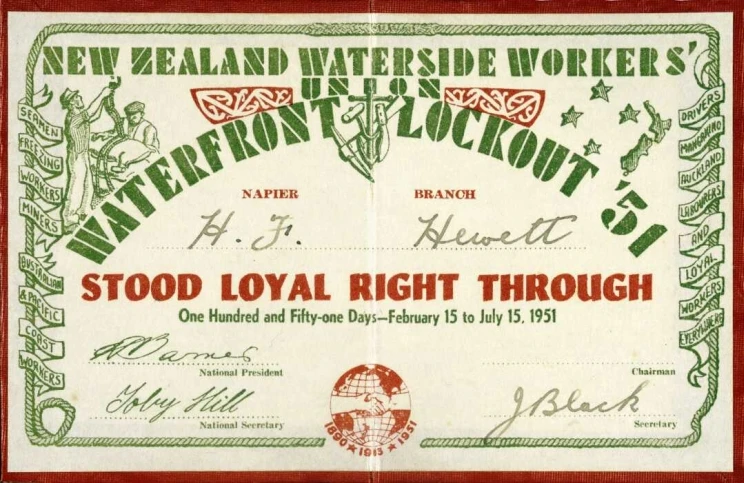
Loyalty card from the 1951 Waterfront Lockout. Ref: Eph-A-LABOUR-1951-01. Alexander Turnbull Library.
Where do I start?
If you want to find more than unpublished material (like books, articles and newspapers) try searching our website.
To only search the catalogue of unpublished collections, use the Alexander Turnbull Catalogue (Tiaki).
Alexander Turnbull Library Catalogue
Use keywords related to your topic like subjects and events, or the names of unions, groups or people. As well as occupational keywords like shearing or forestry, useful keywords include:
labour, labourers
work, worker, workers, working or at work
unionist
activist
feminist
women, women’s
employment, employees or employers
company
industrial
trade
You can also limit or refine your search in different ways, such as by date or format (including digitised content). For example, if you want to find the records created by a union, group or person, change the Level dropdown option to Collection on Alexander Turnbull Library Catalogue. Now you will only find groups of records.
If you want to search by format (like ephemera or diaries) put ephemera or diaries in the Type of Material box. Make sure the format term is a plural, i.e. diaries NOT diary.
The format terms we use come from the:
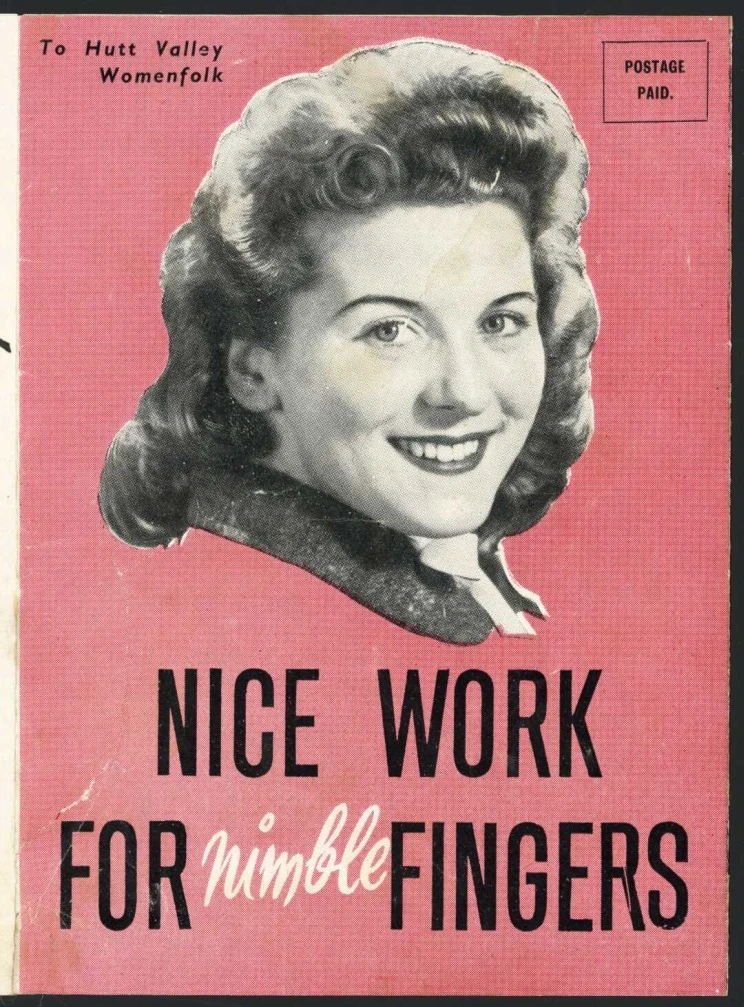
Pamphlet advertising tobacco jobs for women at WD and HO Wills in Lower Hutt. Ref: Eph-A-EMPLOYMENT-1950-01. Alexander Turnbull Library.
What can I view online?
We hold a large (and rapidly growing) collection of digital and digitised content, much of which you can access from home. This guide shows you how to search for digital content and make use of our online e-resources:
Research with our digital content from home
For example, you can find digital content on Alexander Turnbull Catalogue (Tiaki) by using the checkboxes to limit your search to born-digital or digitised content. Thousands of digitised photographs, cartoons and ephemera about working life can be found this way, especially using the Type of Material search box.
Alexander Turnbull Catalogue (Tiaki)
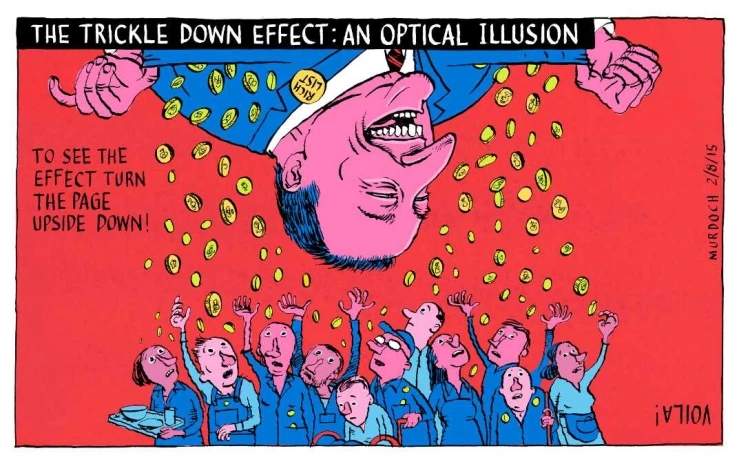
Digital cartoon of the trickle-down effect showing upside down Prime Minister John Key and workers below. Coins are falling from the worker's hands into the pockets of the Prime Minister and those on the 'rich list'. Accompanying note from the cartoonist states: 'Richlist announced. Published Sunday Star Times'. Ref: DCDL-0031632. Alexander Turnbull Library.
Are there restrictions?
Some material has access restrictions, so you may need to seek the permission of the donor, curator or Chief Librarian before you can view it. Some have use restrictions. This means some material can only be viewed at the Library, while others may need special clearances before it can be used elsewhere.
How do I browse by subject?
Browsing by subject is another way to find things. Subject terms (or ‘authorities’) have lists of material linked to them. The subject terms we use include:
Subject terms like industrial relations or unemployment have loads of material linked to them. You can also broaden or narrow your search using associated subjects. For example, within industrial relations there is labour disputes and labour contract and associated terms like employees, each with their own lists.
Subject terms
To search by subject, visit the Subject search area of the Alexander Turnbull Library catalogue and enter your keyword in the Keyword Search box.
This will bring up related subject terms. Clicking on one will display a list of material related to that term.
Alexander Turnbull Library catalogue
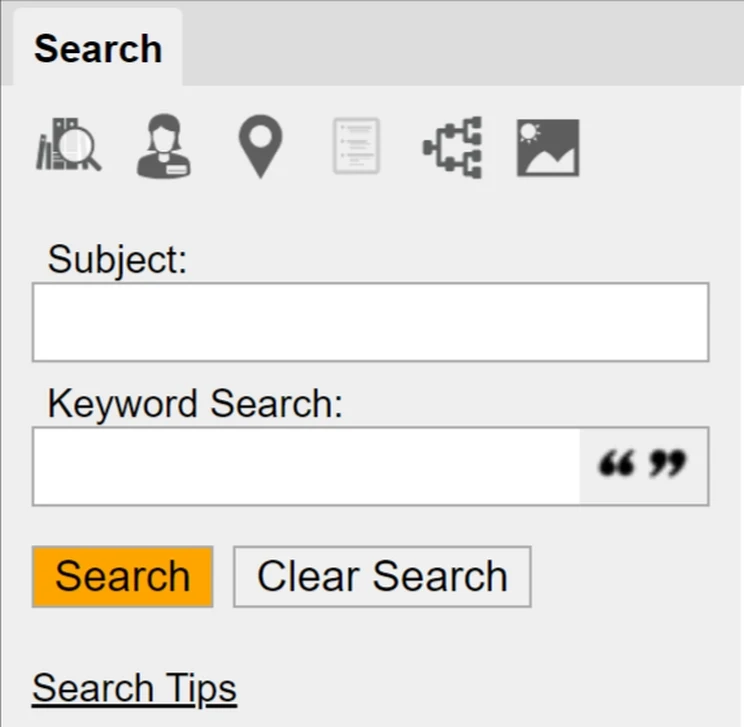
A screenshot of the subject and keyword search boxes of the Alexander Turnbull Library Catalogue (Tiaki), with icons indicating the other categories available to search on.
Subject term examples
Here are some relevant subject terms with material linked to them:
Industrial relations (490+)
Work (70+)
Wages (360+)
Labour (130+)
Employees (145+) which includes narrower terms like Domestics (110+) Agricultural labourers (170+) and other workers
Factories (95+) with narrower terms like Sugar factories (10+) or Textile factories (70+)
Labour movement (140+)
Trade-unions (600+)
Trade unionists (150+)
Fraternal organisations (150+)
Strikes and Lockouts (355+)
Labour disputes (245+)
Labour laws and legislation (100+)
Economic policy (760+)
Economics (150+)
Employment (Economic theory) (220+)
Economic history (95+)
Public works (55+)
Unemployment (510+)
Cost and standard of living (510+)
Pay equity (130+)
Social Classes (40+)
Socialism (215+)
Communism (145+)
Feminism (170+)
Anarchism (25+)
Capitalism (120+)
Political parties (1325+)
Civil rights (95+)
Keyword search
You can also search with these terms in the Keyword Search box to find more subjects. For example, there are 70+ items linked to the subject term work but searching with the keyword work returns over 340 related subjects, each with their own lists.

Gold miners at a union meeting outside Waiuta Miners Hall, c.1930. Ref: PAColl-4796-02. Alexander Turnbull Library.
What manuscripts and archives do you hold?
From diaries to records of industrial disputes, we hold a significant number of manuscripts and archives created by workers, organisations and employers. These unique collections highlight the role of work and collective action in shaping history. The experiences of everyday working life are also documented.
Learn more about the Manuscripts Collection
Personal papers from the workers’ movement
Among the personal papers we hold from the workers’ movement, the Herbert (Bert) Roth collection is especially important. Totalling 35 linear metres, Roth collected the papers of unionists and activists, ephemera such as posters and ‘underground publications’, newspaper clippings, and the official archives of a wide range of trade unions, umbrella associations and organisations — including socialist and communist parties. Some of these date from the beginning of unionism in New Zealand.
Roth also compiled extensive biographical notes and card indexes of people involved in the workers’ movement, as well as the histories of individual unions and political organisations.
Records of individual trade unions — Herbert Roth collection
Papers relating to liberal, socialist and co-operative organizations — Herbert Roth collection
Communist Party and Socialist Unity Party records — Herbert Roth collection
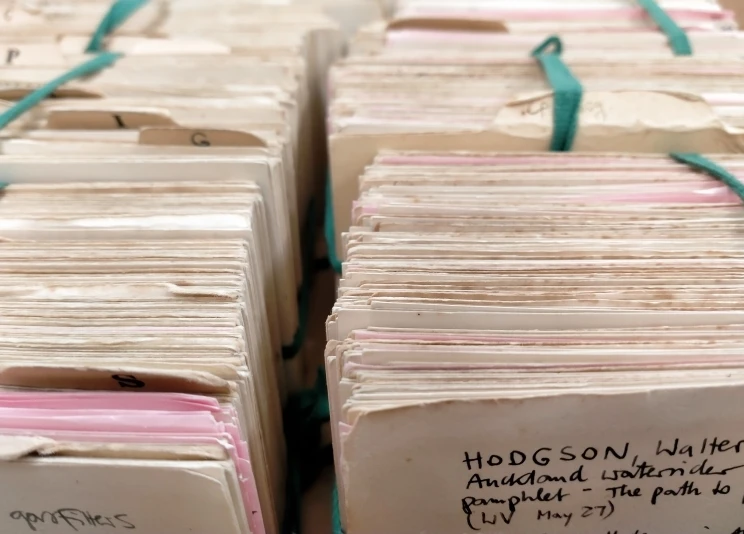
Card index of trade union histories and Communist Party members. Herbert Roth Collection. Ref: 94-106-22/08.
Search for people associated with the workers' movement
To find people associated with the workers’ movement, visit the Names section of Alexander Turnbull Library Catalogue by clicking the person icon and searching with relevant keywords, including occupations. This will bring up people’s names and the lists of items associated with them.
Alexander Turnbull Library Catalogue
Personal papers examples
Here’s a sample of papers we hold:
Personal papers | Years | Linear m. |
|---|---|---|
– unionist, watersider and communist | 1924-1976 | 0.3 |
– includes items on Peter and Janet Fraser, Tim Armstrong | 1919-1999 | 0.21 |
– secretary of the Electrical Workers' Union | 1948-1984 | 1 |
– life-long freezing worker and unionist | 1937-1966 | 0.3 |
– socialist and historian of the union movement | 1918-1972 | 9.5 |
– includes Westport Labour Union material | 1885-1949 | 0.6 |
– socialist, journalist and radical historian | 1882-2003 | 1 |
– avid collector and active in railway unions | 1890-1994 | 40.5 |
– writer, active in workers’ and peace movements | 1910-2001 | 11.26 |
– West Coast unionist, includes Harry Davis papers | 1903-1943 | 0.1 |
– seaman, unionist, Federation of Labour leader | 1914-1963 | 11 |
– active in the New Zealand Footwear Workers' Union | 1940-1992 | 0.15 |
– community worker, socialist, feminist, teacher | 1893-1998 | 3.42 |
– includes indexes to selected Seamen’s Union records | 1902-1932 | 0.08 |
– seaman, secretary of various unions | 1903-1977 | 0.25 |
(further papers I, II) – extensive communist collection | 1920-1990 | 8.6 |
– Irish nationalist, peace activist and unionist | 1911-1974 | 3 |
– contains Wellington Communist Party papers | 1941-1945 | 0.3 |
– trade unionist, writer and socialist politician | 1904-1931 | 0.15 |
– includes Early Childhood Workers' Union material | 1973-2016 | 0.9 |
– American who studied New Zealand labour conditions | 1889-1935 | -- |
– librarian, historian and avid collector | 1840-1994 | 34 |
– Harry Edmund Holland, Annie Holland and sons | 1912-1974 | -- |
– includes Liberal Party and 1890 strike material | 1875-1898 | 0.3 |
– seaman, trade union leader, Minister of Labour | 1890-1912 | 7 |
– Freemans Bay resident and life-long union activist | 1923-1990 | 3.31 |
– scrapbooks on watersiders’ unions, 1951 Lockout | 1951-1953 | 0.14 |
– extensive papers of the Socialist Unity Party | 1924-2005 | 5.5 |
– trade union activist, metal worker and cartoonist | 1930-2013 | 1 |
– scrapbooks on brass bands, including union bands | 1889-1940 | -- |
– Manawatū communist jailed for subversive pamphlets | 1933-1940 | 0.03 |
– secretary to several unions, FOL executive member | 1936-1984 | 5.6 |
– papers cover numerous unions and federations | 1925-1987 | 2 |
(further papers) – Labour Party, unions, left-wing groups | 1899-2012 | 2 |
– extensive papers and recordings about folk songs | 1863-2012 | 3.67 |
(further papers) – teacher, social reformer, active in China | 1941-1988 | 5.6 |
– Scottish-born socialist, journalist, editor, poet | 1858-1931 | 0.2 |
– union ephemera, interviews, mining accident reports | 1919-1973 | 0.05 |
– communist, dancer, teacher, active in theatre | 1918-2005 | 7 |
– Wellington civil servant and communist | 1938-1979 | 0.4 |
– folk song papers, labour songs, 1951 Lockout | 1957-2003 | 0.09 |
– political activities of Ronald and Carmen Smith | 1940-1998 | 0.4 |
– activist, trade union leader, Labour politician | 1944-2003 | 13 |
– workers’ and feminist movement papers | 1970-1972 | 6 |
– unionist, president of the Federation of Labour | 1946-1983 | -- |
– watersider and union leader | 1933-1976 | 3.6 |
– material relating to socialism, Clarion settlement | 1866-1961 | 0.1 |
– economist and writer, public servant | 1886-1975 | 18.4 |
Unions, societies, associations and federations
We hold the official archives of workers’ organisations across various industries, as well as liberal, socialist and co-operative associations. Many of these are large collections and have come to us at different times, meaning there are often further papers from the same organisation or their predecessor.
These collections detail things like membership, welfare, industrial disputes, awards and agreements, workplace safety, education, political action, branch meetings, housing, international solidarity movements, personal correspondence and more.
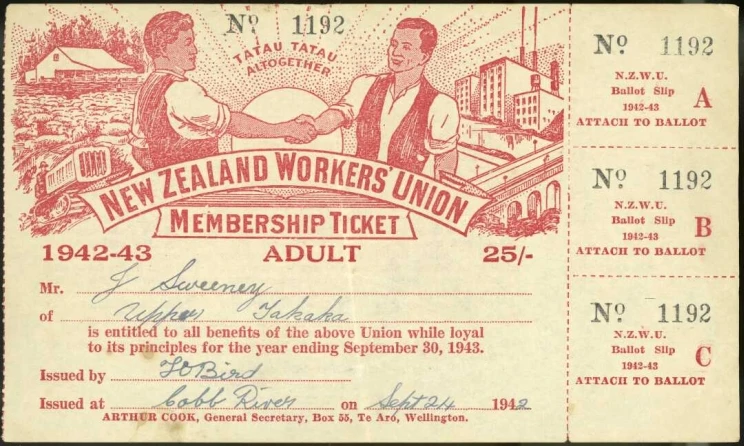
New Zealand Workers' Union Membership ticket, 1942-43. Ref: Eph-A-LABOUR-Davies-1942-01. Alexander Turnbull Library.
Official archives of workers’ organisations held at Alexander Turnbull Library
Everyday working life
Other collections tell us a lot about working life.
The Te Whaiti Family Papers, for example, describe farming, family and Māori life in the Wairarapa from the late nineteenth century onwards.
The Brittenden Family Papers document the lives of three brothers and watermen who emigrated to New Zealand from the 1870s onwards, and are full of commentary on working and social conditions.
The Papers of Edwin Arnold, a Visiting Justice to His Majesty's Prisons and president of the Wellington Discharged Prisoners' Aid Society, detail his prison work between 1898-1922 and contain letters from prisoners and ex-prisoners.
Diaries
Diaries are another valuable source.
Bridget Francois (1902-1992) kept extensive diaries of her career as a nurse across Europe, Ireland, Kentucky (USA), the West Indies, Australian mining camps, Nauru and New Zealand.
The journals of Sarah Pratt provide a snapshot of life in Wiltshire, England – including the Swing Riots of the 1830s – and economic activity in 1840s Nelson.
Margaret Benton (1881-1966) recalls her working life as a domestic servant in her reminiscences.
Hebert Craven, a jobbing carpenter, farm worker and miner, diaries detail his work across the central North Island between the 1900s and 1930s.
The James Cox diaries are particularly unique. From at least 1888 onwards, Cox an itinerant labourer and swagman wrote daily entries on tiny cut-out pieces of paper about his struggles to make a living. By 1925 this remarkable diary came to almost 8000 pages and 800,000 words. You can learn more about Cox – including the Twitter account he inspired – in the blog, Meet the tweeting swagman. The diaries have been digitised.
James Cox diary twitter account
Meet the tweeting swagman

The diaries of James Cox. Ref: MS-0621-0655. Alexander Turnbull Library.
Employer and company records
Although labour history aims to recover the stories of ordinary working-class people, this doesn’t mean it ignores power or the powerful. We hold thousands of records created by employers and companies, from farm stations to fashion, gold mines to the Gear Meat Company.
Papers of employers associations held by Alexander Turnbull Library
We also hold the papers of employers’ associations.
Collection | Years | Linear m. |
|---|---|---|
1898-1990 | -- | |
New Zealand Association of Waterfront Employers and the New Zealand Port Employers Association | 1919-1980 | 70 |
1980-2011 | 10.3 | |
1908-1939 | -- | |
1913-1998 | 29 | |
1856-1970 | 10.66 | |
1869-1999 | 31.3 | |
1921-1988 | 4.3 | |
1940-1979 | 12 | |
1906-1997 | 11 | |
1895-1992 | 4.6 | |
1926-1982 | -- |
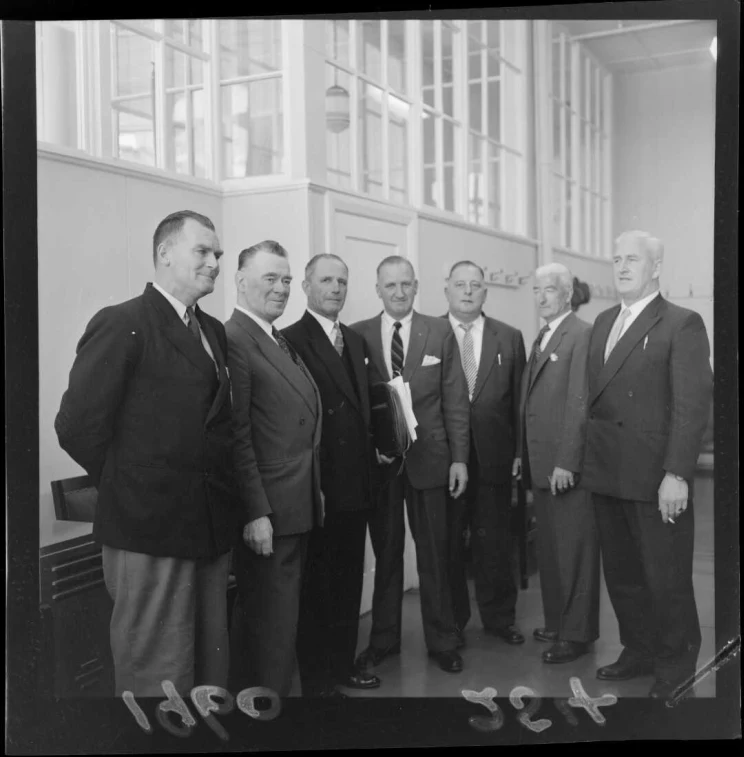
Freezing workers and employers at a Conciliation Conference, Wellington, 1960. Ref: EP/1960/0254-F. Alexander Turnbull Library.
Searching for company records
A useful way to find company records is to change the Level dropdown option to Collection on [Alexander Turnbull Library Catalogue (Tiaki)]
Now using keywords like Company, Association, Federation, Ltd or Co in the Title box will search for these in the titles of collections.
You can also use format terms such as business records, financial records, business correspondence or accounts in the Type of Material box. Firm is also a useful keyword.
Alexander Turnbull Library Catalogue
Do you hold oral history interviews?
We hold many recorded interviews with people talking about their work. These are part of The Oral History and Sound Collection, which consists of more than 10,000 recordings and often include abstracts (a detailed index of a recording with timings), transcribed interviews and related material.
Learn more about the Oral History and Sound Collection
Experiences of work and working life in recorded interviews
Experiences of work and working life feature in many of the recorded interviews – from life as a Māori lineman to working with pit ponies, being a postie or toiling in Wellington’s Chinatown.
The New Zealand Oral History Archive (NZOHA) is very strong on working life, featuring interviews with people from across government departments and the private sector. Smaller projects document the lives of cleaners, women office workers, early IT workers, seafarers, shearers, miners, lawyers and engineers, company owners, market gardeners, the unemployed and more.
Recordings of events
Events have also been recorded, such as American singer Paul Robeson performing for workers at the Addington Railway workshops in 1960, the Federation of Labour’s Special Conference held in March 1951, or seminars like Confrontation '51 and the dissenting life of Rona Bailey.
Paul Robeson sings and talks to Lincoln Efford and other workers at the Railway workshops, Addington
A dissenting New Zealand : a seminar on the life of Rona Bailey
Searching for oral history interviews
You can search for interviews on Tiaki by changing the Level to Interview/Event and using relevant keywords. Using format terms like oral histories or recordings in the Type of Material box is another way to find material.
Examples of oral history collections about work (or the lack of it)
Hidden Treasure mining on the Reefton goldfields oral history project
New Zealand merchant seafarers in the Second World War oral history project
New Zealand Nursing Education and Research Foundation oral history project
New Zealand Workers' Educational Association oral history project
NZOHA Customs Department oral history project Part I, Part II, Part III
Otaki District Commercial Gardeners Society oral history project
Peter Mathews Oral History Collection (gumdiggers and bushmen)
Railway Tradesmens Association. Interviews with former officials, 1973
Selling sex - the New Zealand sex industry oral history project
Women in a Mining Town, Waihi 1883-1993, oral history project
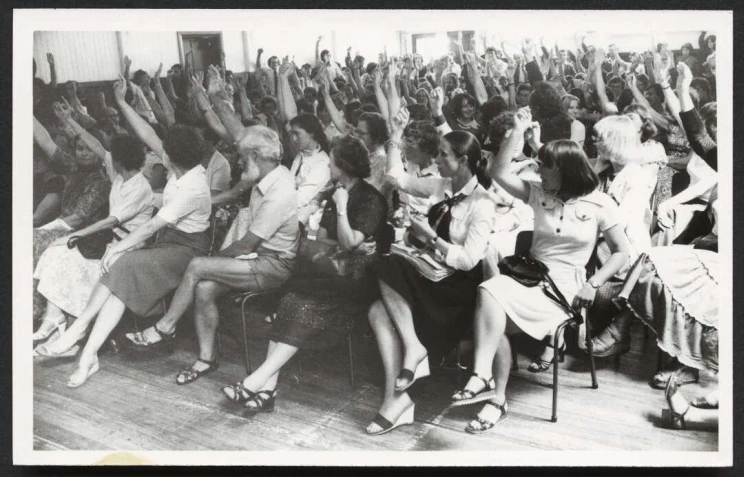
Public service librarians vote to strike. Ref: PAColl-4920-3-5-01. Alexander Turnbull Library.
What about ephemera, cartoons and artwork?
We hold heaps of ephemera, cartoons and artwork. This includes over 200,000 ephemera dating from the 1840s to the present, the New Zealand Cartoon and Comics Archive, and many thousands of drawings, prints, paintings, architectural plans and objects.
Ephemera Collection
Cartoon and Comics Archive
Drawings, Paintings and Prints
Ephemera
Ephemera are everyday items like flyers, pamphlets, posters, newsletters, badges, memes and other material that were often made for a specific purpose. Created by a wide range of people and organisations, they can be found on Alexander Turnbull Library Catalogue by using the format term ephemera in the Type of Material box.
You can also use specific format terms such as posters, badges, stickers, pamphlets and others (a useful list can be found under the Ephemera format term in the Alexander Turnbull Library Catalogue thesaurus.
Alexander Turnbull Library Catalogue (Tiaki)
Alexander Turnbull Library Catalogue thesaurus
Some ephemera are organised by the person who created/collected them, such as Herbert Roth, Rona Bailey and Therese O’Connell. Their surnames are included in the reference (like Eph-C-ROTH or Eph-D-OCONNELL). Others are organised by subject (such as Eph-A-RAIL). Key subjects include: Women, Labour, Employment, Safety, Maori, Retail, Politics, Rail, Elections, Peace, Electricity and Insurance. The letter in the ephemera reference (Eph-A to Eph-F) relates to the size of the material.
Cartoons and comics
As well as memes, political artwork such as cartoons and are a rich visual source. Both Max Bollinger and Len Gale created underground artwork during the 1951 Waterfront Lockout; the Wellington Media Collective enriched social movements with their design; while more recently, cartoonist and former Media Collective member Sharon Murdoch has continued to cover workers’ rights and social conditions.
They’re the same picture: Collecting memes at the Alexander Turnbull Library — blog
New Zealand cartoons — research guide
Comics and zines — research guide
Max Bollinger — cartoonist
Len Gale — Unionist and political activist
Sharon Murdoch — cartoonist
Paintings and objects
We also hold paintings and objects (curios) like murals painted by Judith Evans for the Wellington Unity Centre, or the banner of the Amalgamated Society of Carpenters and Joiners.
You can use the Type of Material box to search for illustrations, prints, cartoons, comics, paintings, watercolours, portraits and other formats.
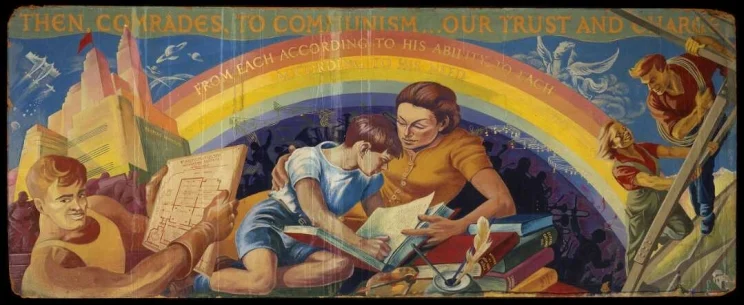
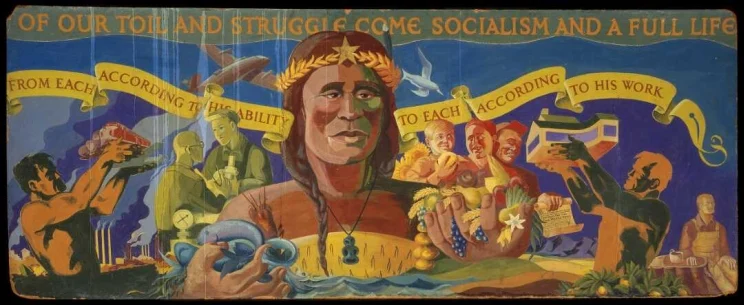
Murals painted for the Friends of the Soviet Union by Judy Evans and her father Guy Harding at the Unity Centre, Wellington, 1944. Ref: F-020 and F-019. Alexander Turnbull Library.
Do you hold photographs?
Our Photographic Archive is one of New Zealand’s foremost collections of photographs. It contains around 1,600,000 items from the 1840s to the present and documents many aspects of New Zealand’s economic activity and working life.
You can find collection items in the Photographic Archive by using the Alexander Turnbull Library Catalogue (Tiaki), or you can browse and search half a million digital images on the National Library website. Many high-resolution images can be downloaded for free.
What do you hold on Māori economic activity?
As Hazel Petrie notes in Chiefs of Industry, traditional Māori work was seasonal, involved whole whānau and hapū and formed part of an economy based on mana and reciprocity. Missionaries and other Pākehā observers recorded their observations of Māori economic activity, including trade networks within and beyond Aotearoa. As well as owning their own ships, mills and timber yards in the 1830s and 1840s, Māori were also some of the earliest timber workers, seafarers and shearers.

Unidentified Māori whaler resting on the throat grooves of a whale at a whaling station, Bay of Islands. Whites Aviation Ltd: Photographs. Ref: WA-25237-G. Alexander Turnbull Library, Wellington, New Zealand.
By the twentieth century Māori workers were increasingly part of the union movement. As a result, information about Māori economic activity can be found throughout the collections, including the material already listed in this guide. We also have online resources that can help.
Te rāngai mahi – Māori in the workforce — Te Ara, The Encyclopedia of New Zealand
Ngā uniana – Māori and the union movement — Te Ara, The Encyclopedia of New Zealand
Te Kupenga: 101 Stories of Aotearoa from the Turnbull
Te Kupenga: Stories of Aotearoa New Zealand is an online collection of items from the book Te Kupenga: 101 Stories of Aotearoa from the Turnbull. It contains stories of Māori social and economic life, including:
Hākari — an occasion for hospitality featuring food
Digging for livelihoods — about gum diggers
Whaling in the bay — Whangamumu whaling
Custom meets colonisation — harvesting and preserving birds like tītī, and
Selling a farming dream — Pūhoi farming and Ngāti Rongo.
Topic Explorer
The National Library’s Topic Explorer and other online learning resources also feature Māori economic activity. Relevant topics include:
Browsing by subject for Māori economic activity
Browsing by subject in the Subject search area of Alexander Turnbull Library Catalogue is also a useful way to find material about Māori economic activity.
Here are some relevant subject terms with material linked to them:
Māori (New Zealand people) - Land tenure (separate terms with this heading also exist for regions)
Māori (New Zealand people) - Missions (separate terms with this heading also exist for regions)
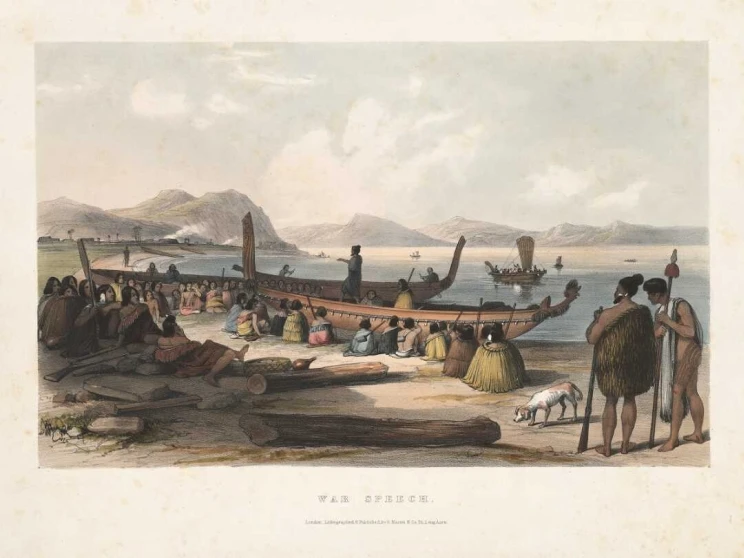
Māori gathered in Pēwhairangi, the Bay of Islands, as depicted by Augustus Earle. Ref: PUBL-0015-09. Alexander Turnbull Library.
What do you hold on the wider Pacific?
We hold a considerable amount of material from or about the wider Pacific, including photography, published and unpublished collections, online resources and more. Our Pasifika – Family history guide is a great place to start.
Among the papers relating to the wider Pacific are those of Robert McNab, which cover sealing, whaling, exploration and trade before 1840 – including shipping information and disputes between captains and crew. Michael Bellam, a Lecturer in Geography at Victoria University, collected a large amount of material on twentieth century economics in the Pacific like the British Solomon Islands’ copra industry or the wider fruit and vegetable industry. We also hold single items like the 1940 pocket diary of George Simpson, who recorded his year working as a labourer for the Public Works Department on Raoul Island.
Plantation labour regimes
There is a long history of plantation labour regimes in the Pacific, including indentured labour and blackbirding. You can find related material by searching with relevant keywords, including in the Subject search area of the Alexander Turnbull Library Catalogue (Tiaki). These include the:
The private diary of Capt Johnson (available to view online) details the daily activities aboard a labour recruiting vessel between Fiji and the Solomon Islands in 1890.
Material about union activity in the wider Pacific, including the South Pacific Trade Union Forum, can be found in the Herbert Roth collection (General trade union records), the Conrad Bollinger papers), and various Federation of Labour, Seamen’s Union and Drivers’ Federation records.
Conrad Bollinger papers, Federation of Labour — Overseas labour organisations - Correspondence, conferences
Pacific Manuscripts Bureau
We also hold several Pacific Manuscripts Bureau collections on microfilm. These include records of the:
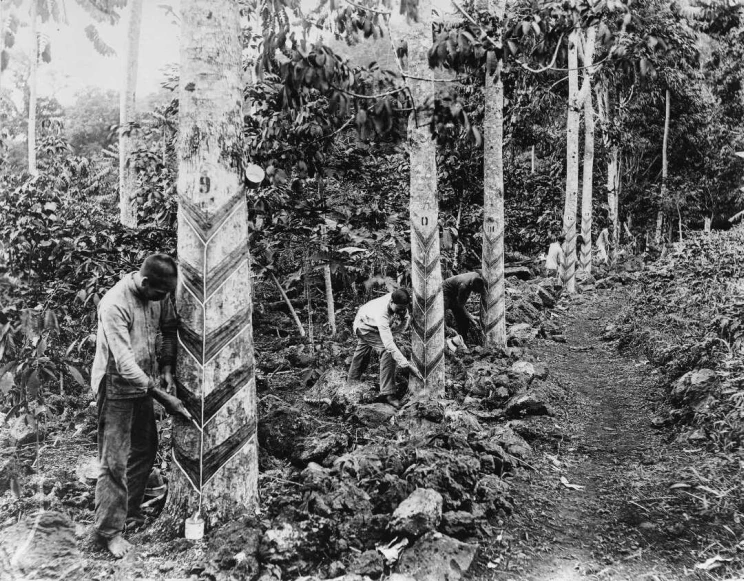
Chinese workers tapping rubber trees in Sāmoa. Ref: 1/2-020691-F. Alexander Turnbull Library.
Where else can I look?
Published material about labour history
Published material such as newspapers, pamphlets, articles, books and journals are an important source of labour history and can be found on the National Library Catalogue.
For example, many unions and workers’ organisations published their own newspapers. Not all of these have been digitised and added to Papers Past, but some digitised newspapers that have a strong worker focus include:
Official government publications
Official government publications are also a useful source. The Journal of the Department of Labour(1893-1917) details industrial relations and working conditions, while awards and agreements were also published by the Department of Labour (you can find these on the New Zealand Legal Information Institute database, at Archives New Zealand, or on the National Library Catalogue by using the keywords awards agreements). The Appendix to the Journals of the House of Representatives (AJHR), sometimes known as ‘the A to Js’, contains government-related reports published every year from 1858 and can be searched on the Parliamentary Papers section of Papers Past.
Journal of the Department of Labour National Library Catalogue
New Zealand Book of Awards — Decisions 1898-1978 online database
Appendix to the Journals of the House of Representatives (AJHR)
Books theses and articles on labour history
Books, theses and articles on labour history are a useful way to locate archival material, as references can point to hard-to-find material. Catalogues and bibliographies are also helpful, such as A guide to the archives of the New Zealand Federation of Labour, 1937-88 by Cathy Marr or Words at work: An annotated bibliography of New Zealand trade union literature by Paul Corliss.
You can find more on the National Library Catalogue by using the keywords labour bibliography or similar terms).
A guide to the archives of the New Zealand Federation of Labour, 1937-88 by Cathy Marr
Words at work: An annotated bibliography of New Zealand trade union literature by Paul Corliss
Unions
Some unions still maintain their own records. The New Zealand Council of Trade Unions and The Companies Office Registered Unions have details about existing unions.
Other repositories
Material can also be found within other repositories. The community archives directory is a useful tool to find these.
Directory of community archives
Some relevant New Zealand repositories include:
Archives New Zealand – as the government archive it holds millions of records on economic activity, including trades and training, union awards and agreements, companies, patents, bankruptcy, private employment, government employment and the public service. Their Employment guide contains useful information
Auckland Libraries Heritage Collections – includes a wide range of material and formats, such as the Grey New Zealand Māori Manuscript Collection, thousands of heritage photographs, oral histories and more
Fletcher Trust Archives – holds forestry, pulp and paper, public works and other industry archives
Hocken Collections – as well as being strong on economic activity and unions relating to Otago, it holds the papers of E.J. Howard, Noel Hilliard, some Union Steam Ship Company records and the archives of the Otago Southland Employers’ Association
Iwi repositories such as Ngāi Tahu’s Kareao hold material about Māori economic activity
J C Beaglehole Room, Victoria University of Wellington Library
Union records held at Victoria University of Wellington Library
Ngā Taonga Sound and Vision – among the collection are recordings and moving images of interviews, news bulletins, radio features, documentaries and more related to work and the workers’ movement.
Fighting Back held by Ngā Taonga Sound and Vision is about the 1949 carpenters’ dispute) and over 1500 recordings from the weekly radio documentary series 'Spectrum'
University of Auckland Special Collections – holds the largest collection of trade union records in Auckland, dating back to 1873 and covering many Auckland branches. They also hold the papers of socialists and communists, as well as a large collection of Pacific material
University of Canterbury Library – The Macmillan Brown Library is Canterbury’s largest repository of trade union archives. They hold minute books, correspondence and financial papers from a variety of unions dating back to the 19th century.
University of Waikato – archives include Huntly mining records, papers of a waterside worker, Len Gale material and considerable archives relating to Māori activity, such as the papers of Pei Te Hurinui Jones
Waitangi Tribunal — inquiry document bank contain a wealth of information on Māori economic activity and change within particular rohe
Wellington City Archives – holds records of the Union Steamship Company, including diaries, wage disputes and awards, and extensive documents on the 1912 Tramway Strike
Online resources
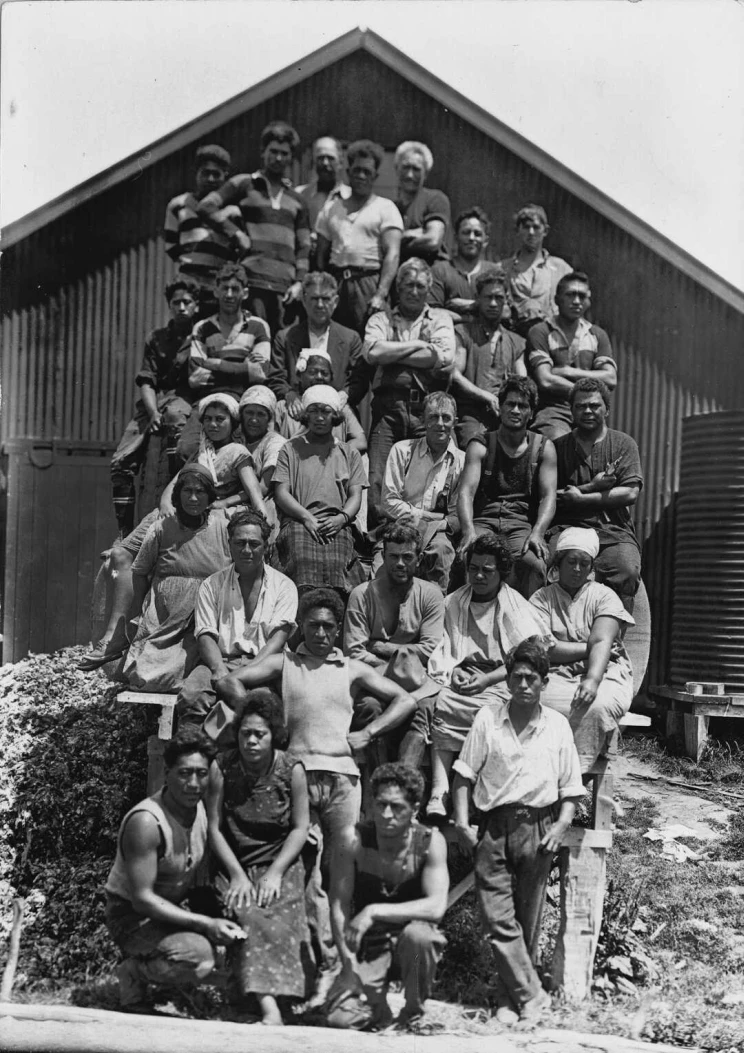
Unidentified sheepfarm workers, East Coast, c.1906. Ref: 1/2-018017-F. Alexander Turnbull Library.
Acknowledgements
Many hands helped to make this guide. Thank you to everyone who made suggestions, corrections and contributed their expertise.
Author: Jared Davidson, June 2022
Related content
Research with our digital content from home
This guide will help you start using digital content from the National Library and Alexander Turnbull Library from home.Help
Where do I start? What do I look for first? Am I even in the right place? Starting your research is always a bit confusing, but we can help out. Have a look at the tips on this page for how to start your research using our website.
Making the most of your visit
Information to help you make the most of your valuable research time and get the most out of our collections and resources. Search the collections and our catalogues to find the records of material we hold. You can access some resources from home.Feature image at top of page — Workers outside a Bonded Tobacco Factory, ca. 1920. Ref: 1/1-017327-G. Alexander Turnbull Library.